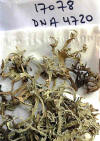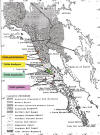|
Niebla pulchribarbara Rocky mesa E of San Antonio del Mar, Spjut & Sérusiaux 17015, Jan 2016 |
Rocky mesa E of San Antonio del Mar, Spjut & Sérusiaux 17014c-5041, Jan 2016. Specimen photo taken under hotel room light in San Quintín soon after collected. |
Niebla pulchribarbara Rocky mesa E of San Antonio del Mar,
Spjut & Marin 11182,
|
||
     Niebla pulchribarbara x N. palmeri? Between El Rosario and Punta Baja, Spjut & Sérusiaux 17078, phylogeny in depsidone clade. Specimen collected between El Rosario and Punta Baja, N 30°00.075 W 115°45.965' 140 m. TLC on separate occasions from the same collection show different results. One found with protocetraric acid, and with triterpenes, the other found hypoprotocetraric acid and also with triterpenes. Image color modified by autotone in Adobe Photoshop to accentuate triterpenes. Divaricatic acid normally yellow.
|
||||
|
Niebla pulchribarbara was originally described by Rundel and Bowler from a vegetation study they conducted at Bahía de San Quintín (Rundel et al. 1972); however, Bowler and Marsh (2004), felt it was no longer worthy of recognition and treated it as a synonym of N. josecuervoi, a species that had also been described by Rundel and Bowler in the same study (Rundel et al. 1972). The authors of N. pulchribarbara did not indicate its relative abundance as they did for other species, apparently because they distinguished N. pulchribarbara from N. josescuervoi by the terricolous habit (Rundel 1978) rather than by secondary lichen substances as was later done by Spjut (1996). Moreover, N. josecuervoi is recognized without a well defined attachment point as shown for specimens collected on Punta Canoas (e.g., Spjut 11297) The morphological features of Niebla pulchribarbara appear intermediate between N. josecuervoi and N. effusa as evident by the development and shape of branchlets. Niebla pulchribarbara differs slightly from these related species in the longer branchlets, but relatively few specimens are known so it is difficult to draw any taxonomic conclusions on this one feature. The thallus lacking any clear dominant branch and the relatively rigid branches with raised longitudinal cortical ridges are features shared with N. effusa. The appearance of long secondary branchlets, often close together along the upper side of a primary branch, is also similar to N. josecuervoi. In view of the limited material for study, it seems best to identify N. pulchribarbara by the lichen substance, protocetraric acid. Spjut & Sérusiaux discovered other specimens with protocetraric acid. These appear to be hybrids by the additional lichen substances of triterpenes and other depsidones. However, these anomalous thalli cluster in a phylogeny from different locations; thus, they may actually represent a distinct species complex. Additional references cited: Bowler, P. A. and J. Marsh. 2004. Niebla. Lichen Flora of the Greater Sonoran Desert 2: 368–380. Rundel, P.W. 1978. Ecological relationships of desert fog zone lichens. The Bryologist 81: 277–293. Rundel, P.W., P.A. Bowler & T.W. Mulroy. 1972. A fog-induced lichen community in northwestern Baja California, with two new species of Desmazieria. The Bryologist 75: 501–508. Further references: See Niebla. |





